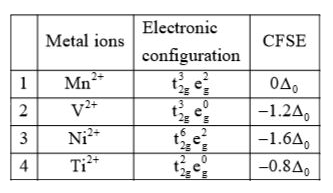For the complex [Cr(H2O)6]2+ calculate the total pairing energey in high spin and low spin state Given the mean pairing energey =23500cm−1 .
To solve the problem of calculating the total pairing energy in the high spin and low spin states for the complex (Cr(H2O)6)2+, we will follow these steps:
Step 1: Determine the oxidation state of chromium
The complex is (Cr(H2O)6)2+. Since water is a neutral ligand, the oxidation state of chromium can be calculated as follows:
Let the oxidation state of chromium be x. The equation becomes:
x+0=+2(since the overall charge of the complex is +2)
Thus, x=+2.
Step 2: Write the electronic configuration of chromium
The atomic number of chromium (Cr) is 24. The ground state electronic configuration of chromium is:
(Ar)4s13d5
For Cr2+, two electrons are removed (one from the 4s and one from the 3d):
Cr2+:4s03d4
Step 3: Identify the type of coordination geometry
The complex (Cr(H2O)6)2+ has a coordination number of 6, which indicates an octahedral geometry.
Step 4: Determine the electron distribution in high spin and low spin states
In an octahedral field, the 3d orbitals split into two sets: t2g (lower energy) and eg (higher energy).
High Spin State:
For a high spin state, electrons fill the orbitals singly before pairing occurs. For 3d4:
- The distribution is:
- t2g: 3 electrons (1 in each orbital)
- eg: 1 electron
Thus, the filling looks like this:
- t2g: ↑ ↑ ↑
- eg: ↑
Total Pairing Energy in High Spin State:
Since there is no pairing in the high spin state, the total pairing energy is:
Total Pairing Energy (High Spin)=0cm−1
Low Spin State:
For a low spin state, electrons pair up before filling the higher energy orbitals. For 3d4:
- The distribution is:
- t2g: 4 electrons (2 pairs and 1 single)
- eg: 0 electrons
Thus, the filling looks like this:
- t2g: ↑↓ ↑↓ ↑
- eg:
Total Pairing Energy in Low Spin State:
In the low spin state, there is 1 pairing (since 4 electrons are present in t2g):
Total Pairing Energy (Low Spin)=1×Mean Pairing Energy=1×23500cm−1=23500cm−1
Final Results:
- Total Pairing Energy (High Spin) = 0 cm−1
- Total Pairing Energy (Low Spin) = 23500 cm−1
The complex is (Cr(H2O)6)2+. Since water is a neutral ligand, the oxidation state of chromium can be calculated as follows:
x+0=+2(since the overall charge of the complex is +2)
Thus, x=+2.
The atomic number of chromium (Cr) is 24. The ground state electronic configuration of chromium is:
(Ar)4s13d5
For Cr2+, two electrons are removed (one from the 4s and one from the 3d):
Cr2+:4s03d4
The complex (Cr(H2O)6)2+ has a coordination number of 6, which indicates an octahedral geometry.
In an octahedral field, the 3d orbitals split into two sets: t2g (lower energy) and eg (higher energy).
For a high spin state, electrons fill the orbitals singly before pairing occurs. For 3d4:
- The distribution is:
- t2g: 3 electrons (1 in each orbital)
- eg: 1 electron
- t2g: ↑ ↑ ↑
- eg: ↑
Since there is no pairing in the high spin state, the total pairing energy is:
Total Pairing Energy (High Spin)=0cm−1
For a low spin state, electrons pair up before filling the higher energy orbitals. For 3d4:
- The distribution is:
- t2g: 4 electrons (2 pairs and 1 single)
- eg: 0 electrons
- t2g: ↑↓ ↑↓ ↑
- eg:
In the low spin state, there is 1 pairing (since 4 electrons are present in t2g):
Total Pairing Energy (Low Spin)=1×Mean Pairing Energy=1×23500cm−1=23500cm−1
- Total Pairing Energy (High Spin) = 0 cm−1
- Total Pairing Energy (Low Spin) = 23500 cm−1
Topper's Solved these Questions
- COORDINATION COMPOUNDSBOOK - CENGAGE CHEMISTRY ENGLISHCHAPTER - COORDINATION COMPOUNDSEXERCISE - Solved Examples
42 Videos
- COORDINATION COMPOUNDSBOOK - CENGAGE CHEMISTRY ENGLISHCHAPTER - COORDINATION COMPOUNDSEXERCISE - Ex 7.1 Subjective (Terminology)
5 Videos
- CHEMICAL KINETICSBOOK - CENGAGE CHEMISTRY ENGLISHCHAPTER - CHEMICAL KINETICSEXERCISE - Archives Subjective
23 Videos
- D AND F BLOCK ELEMENTSBOOK - CENGAGE CHEMISTRY ENGLISHCHAPTER - D AND F BLOCK ELEMENTSEXERCISE - Archives Subjective
29 Videos
Similar Questions
[Co(H2O)6]3+ complex is
View SolutionThe complex [Cr(H2O)4Br2]Cl gives the test for :
View SolutionFor the [Cr(H2O)6]2+ ion, the mean pairing energy P is found to 23500cm−1. The magnitude of Δ0 is 13900cm−1. Calculate the C.F.S.E. (cm−1) for this complex ion corresponding to high spin state (x) and low spin state (y). Write your answer as (y−x100).
View SolutionSelect incorrect match for [M(H2O)6]2+ complex.

View SolutionThe degenerate orbitals of [Cr(H2O)6]3+ are :
View SolutionThe complex [Cr(H2O)5Cl]Brand[Cr(H2O)5Br]Cl show
View SolutionThe degenerate orbitals of [Cr(H2O)6]3+ are:
View SolutionThe valency of Cr in the complex [Cr(H2O)4Cl2]+
View Solution(a) For the complex [Fe(H2O)6]3+ , write the hybridization, magnetic character and spin of the complex. (At. Number : Fe =26)
(b) Draw one of the geometrical isomers of the complex [Pt(en)2Cl2]2+ which is optically inactive.
View Solution(a) For the complex [Fe(H2O)6]3+ , write the hybridization, magnetic character and spin of the complex. (At. Number : Fe=26)
(b) Draw one of the geometrical isomers of the complex [Pt(en)2Cl2]2+ which is optically inactive.
View Solution
